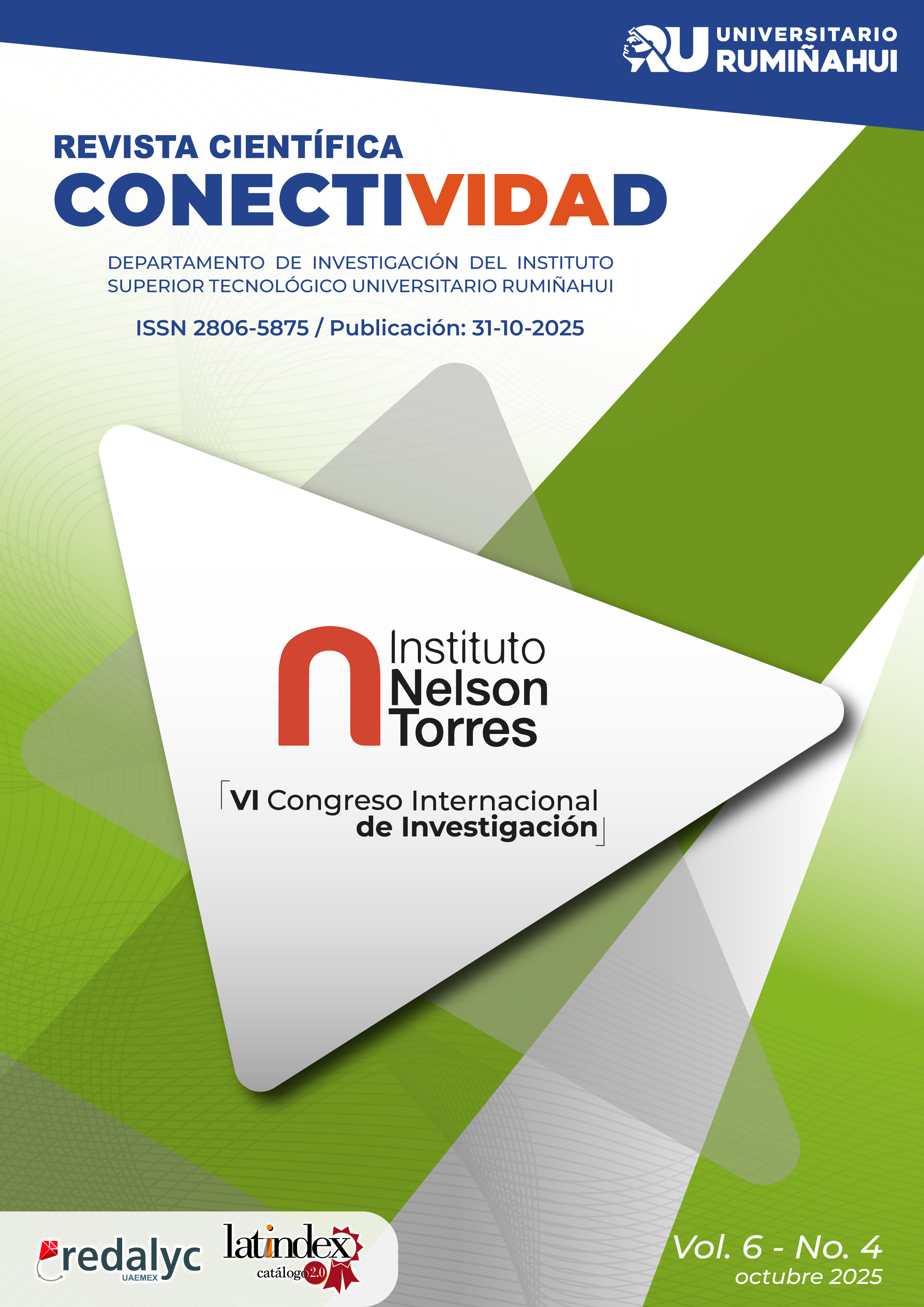The Use of Artificial Intelligence and Its Influence on the Creative Thinking of Graphic Design Students in Latacunga.
DOI:
https://doi.org/10.37431/conectividad.v6i4.358Keywords:
Artificial Intelligence, Graphic Design, CreativityAbstract
Following the 1980s, designers underestimated digital technology, labeling it as unprofessional; however, other designers were able to adapt to the new changes. This article aims to analyze the use of artificial intelligence and its influence on the creative thinking of Graphic Design students in Latacunga, thanks to Graham Wallas's methodology with its four phases to be evaluated using the Likert scale. Subsequently, the threshold and outlier method was used, generating three thresholds respectively. The last instrument used was the survey on the use of AI among students for the 2025 academic year. In this sense, graphic design education must adhere to the principles of G. Wallas's theory, given that it is a fundamental discipline for activating and stimulating students' creative thinking. It is essential that the future professional develops the ability to discern between an original design and a computer-generated one, understanding that AI tools are mere references. The appropriation of AI-assisted content must be analyzed to safeguard and enhance the designer's intrinsic creativity.
References
Abeliuk, A., & Gutiérrez, C. (2021). Historia y evolución de la inteligencia artificial. Revista Bits de Ciencia, (21), 14-21. https://jfborges.wordpress.com/2024/01/26/historia-y-evolucion-de-la-inteligencia-artificial/
Barreto Ascona, J. I., & Lezcano Mencia, A. (2023). Análisis y fundamentación de los diseños de investigación: explorando los enfoques cuantitativos, cualitativos y mixtos basados en Creswell & Creswell (2018). Revista UNIDA Científica, 7(2), 110–117. https://revistacientifica.unida.edu.py/publicaciones/index.php/cientifica/article/view/179
Escudero Fernández, S. (2024). Inteligencia Artificial en Illustrator. Percepción y exploración en estudiantes de diseño gráfico. European Public & Social Innovation Review, 9, 1–19. https://doi.org/10.31637/epsir-2024-670 DOI: https://doi.org/10.31637/epsir-2024-670
Guilera, L. (2020). Anatomía de la creatividad. Ediciones Paidós. https://books.google.com.ec/books?id=7MbpDwAAQBAJ&lpg=PA11&ots=1RI7Tcuhf1&dq=la%20creatividad&lr&hl=es&pg=PA25#v=onepage&q&f=false
Hoffmann, A. F., Vigh, C. S., & Fernández-Liporace, M. (2021). Creatividad y Enfoques de Aprendizaje en Estudiantes Universitarios. Psicogente, 24(46), 1-17. https://doi.org/10.17081/psico.24.46.4492 DOI: https://doi.org/10.17081/psico.24.46.4492
Jara, M. I. D. V. Y., Martínez, O. L., Navarro, V. N., & Cuéllar, F. (2023). Escritura, creatividad e inteligencia artificial. ChatGPT en el contexto universitario. Comunicar: Revista Científica de Comunicación y Educación, (77), 47-57. https://doi.org/10.3916/C77-2023-04 DOI: https://doi.org/10.3916/C77-2023-04
López Cruz, E. Y., González-Bello, E. O., & Morales-Holguín, A. (2023). Fomento de creatividad y pensamiento creativo como innovación de la educación superior. Zincografía, 7(13). https://doi.org/10.32870/zcr.v7i13.197 DOI: https://doi.org/10.32870/zcr.v7i13.197
Machuca Yaguana , J. A., Maldonado Machuca, M. E., & Vinces, F. V. (2023). Tratamiento y representación de datos provenientes de escalas tipo Likert. Ciencia Latina Revista Científica Multidisciplinar, 7(4), 736-747. https://doi.org/10.37811/cl_rcm.v7i4.6905 DOI: https://doi.org/10.37811/cl_rcm.v7i4.6905
Madriz, J. M. C. (2023). Revolución tecnológica digital en el Diseño Gráfico (1990-2020): ¿evolución, reinvención o automatización creativa? ESCENA Revista de las Artes, 83(1), 98-124. https://doi.org/10.15517/es.v83i1.55869 DOI: https://doi.org/10.15517/es.v83i1.55869
Martinez, A., Dennis, R., Cáceres, Y., Gutiérrez, Y., Quiroz, J., & Acevedo, E. (2023). Inteligencia artificial y su repercusión en los diseñadores gráficos en Panamá. Revista Semilla Científica, 1(4), 513–523. https://doi.org/10.37594/sc.v1i4.1295 DOI: https://doi.org/10.37594/sc.v1i4.1295
Ocaña, F. (2016) Tratamiento estadístico de outliers y datos faltantes. https://www.ugr.es/~fmocan/MATERIALES%20DOCTORADO/Tratamiento%20de%20outliers%20y%20missing.pdf
Pacherres, E. M. L., & Ramírez, W. E. G. (2021). La creatividad en los estudiantes: una Revisión Sistemática. Polo del Conocimiento: Revista científico-profesional, 6(10), 14. https://doi.org/10.23857/pc.v6i10.3213
Rodríguez, P., & Díaz, N. (2024). Estudios sobre la inteligencia artificial como herramienta del diseño gráfico: una investigación documental. Artificio, (5), eB1-eB20. https://doi.org/10.33064/artificio520244772 DOI: https://doi.org/10.33064/artificio520244772
Ruiz Morales, Y. E. (2022). Pensamiento creativo. https://ecosistema.buap.mx/server/api/core/bitstreams/3d8ced93-be3d-4a39-82c9-4a3c88e347f7/content
Tapia, F. D. S. (2024). El Diseño gráfico automatizado: un análisis crítico detrás de la inteligencia artificial. Eídos, 17(24), 81-93. https://dialnet.unirioja.es/servlet/articulo?codigo=9879209 DOI: https://doi.org/10.29019/eidos.v17i24.1377
Published
How to Cite
Issue
Section
Categories
License
Copyright (c) 2025 Instituto Superior Tecnológico Universitario Rumiñahui

This work is licensed under a Creative Commons Attribution-NonCommercial 4.0 International License.
The originals published in the electronic edition under the first publication rights of the journal belong to the Instituto Superior Tecnológico Universitario Rumiñahui; therefore, it is necessary to cite the source in any partial or total reproduction. All the contents of the electronic journal are distributed under a Creative Commons Attribution-Noncommercial 4.0 International (CC-BY-NC 4.0) license.







2.png)





